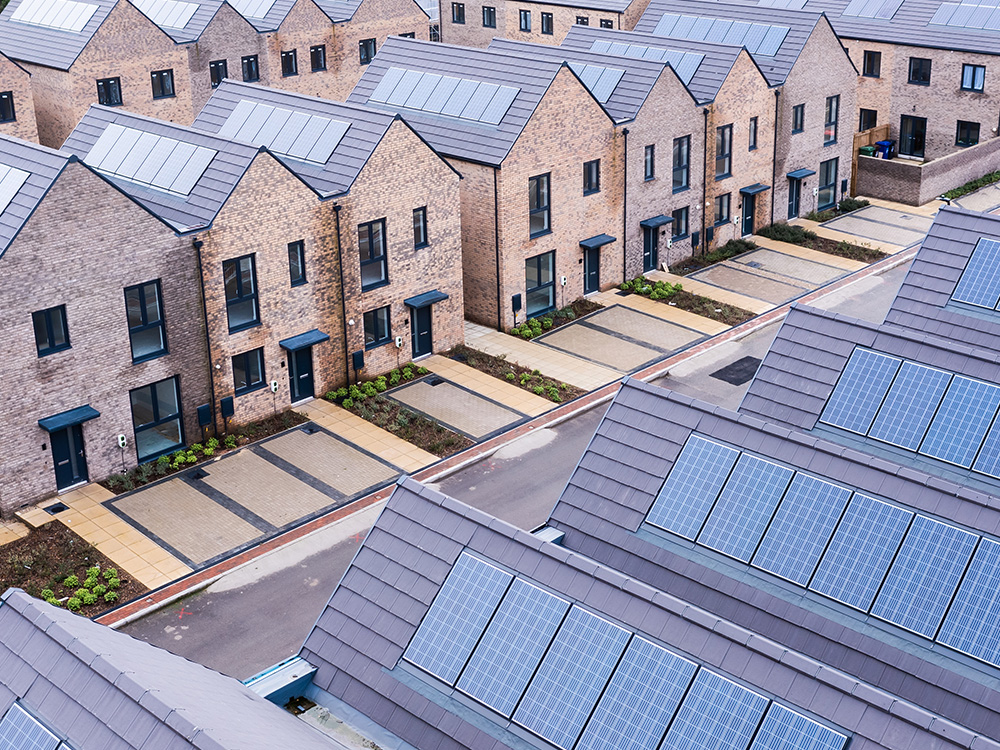On this page
New Build Housing and Development in the UK Where are New Houses Being Built in the UK? Top 50 New Build Locations in the UK Where is the Biggest Housing Shortage in the UK? How Many New Builds Are There in the UK? Do New Builds Hold Their Value in the UK? Do New Builds Go Up in Value in the UK? Is There a Shortage of Houses in the UK? Why Don't They Build More Houses in the UK? What Percentage of New Builds Are Social Housing in the UK? Final ThoughtsNew Build Housing and Development in the UK
New build housing and development play a crucial role in meeting the demand for homes and addressing the housing shortage in the United Kingdom.
This article will cover various aspects related to new build housing in the UK, including locations of new house construction, housing shortage areas, the number of new builds, their value retention, housing scarcity issues, reasons behind limited construction, and the percentage of new builds designated as social housing.
If you're a developer, investor, or interested in the UK housing market, this article will offer valuable insights into new build housing and development.

Where are New Houses Being Built in the UK?
New houses are being constructed throughout the UK, with development projects occurring in both urban and rural areas.
Some of the prominent regions with significant new build housing activity in 2022 include the Northwest, the Southwest and London, and areas surrounding major cities such as Salford. Milton Keynes and Edinburgh. The top 50 New Build Locations in the UK can be seen below.
However, new house construction is not limited to these regions, as various local authorities and developers actively undertake projects nationwide.
Top 50 New Build Locations in the UK
| Region | Local Authority | Total Number Of New Builds 2020-2021 |
Total Number Of New Builds 2021-2022 |
|---|---|---|---|
| North West | Salford | 1,350 | 2,530 |
| South West | Wiltshire | 2,040 | 2,490 |
| London | Tower Hamlets | 2,870 | 2,470 |
| South East | Milton Keynes | 1,470 | 2,350 |
| East of England | Central Bedfordshire | 1,290 | 2,320 |
| South East | Buckinghamshire | 1,800 | 2,310 |
| South West | Cornwall | 1,930 | 2,210 |
| Scotland | City of Edinburgh | 1,920 | 2,160 |
| West Midlands | Birmingham | 950 | 1,980 |
| North West | Liverpool | 470 | 1,940 |
| Scotland | South Lanarkshire | 1,120 | 1,880 |
| North West | Manchester | 3,220 | 1,790 |
| Scotland | Aberdeen City | 860 | 1,780 |
| Yorkshire and The Humber |
Leeds | 2,750 | 1,690 |
| Yorkshire and The Humber |
East Riding of Yorkshire | 1,350 | 1,680 |
| North East | County Durham | 1,290 | 1,670 |
| East Midlands | North Northamptonshire | 1,190 | 1,580 |
| Scotland | Highland | 920 | 1,560 |
| North West | Cheshire East | 1,460 | 1,540 |
| East Midlands | West Northamptonshire | 1,430 | 1,510 |
| South West | South Gloucestershire | 1,340 | 1,510 |
| North East | Northumberland | 1,350 | 1,500 |
| London | Southwark | 2,090 | 1,390 |
| Yorkshire and The Humber |
Wakefield | 1,130 | 1,370 |
| West Midlands | Telford and Wrekin | 950 | 1,350 |
| London | Newham | 1,530 | 1,320 |
| South East | Maidstone | 1,250 | 1,310 |
| North West | Trafford | 610 | 1,280 |
| West Midlands | Stratford-on-Avon | 1,120 | 1,270 |
| South West | Dorset | 1,080 | 1,230 |
| London | Croydon | 1,250 | 1,180 |
| North East | Newcastle upon Tyne | 1,130 | 1,150 |
| North West | Cheshire West and Chester | 990 | 1,120 |
| North West | Wigan | 1,330 | 1,120 |
| Scotland | Fife | 910 | 1,110 |
| East of England | South Cambridgeshire | 910 | 1,100 |
| London | Wandsworth | 780 | 1,090 |
| Scotland | Aberdeenshire | 790 | 1,080 |
| Northern Ireland | Armagh City, Banbridge and Craigavon |
800 | 1,060 |
| Yorkshire and The Humber |
Harrogate | 830 | 1,050 |
| West Midlands | Shropshire | 1,060 | 1,030 |
| East Midlands | South Derbyshire | 940 | 1,000 |
| London | Ealing | 740 | 980 |
| East Midlands | Nottingham | 260 | 970 |
| South East | Wokingham | 1,020 | 960 |
| South East | Vale of White Horse | 920 | 960 |
| South West | North Somerset | 540 | 950 |
| South West | South Somerset | 660 | 950 |
| South East | Cherwell | 890 | 920 |
Source: ONS - House building, UK: completed by local authority.
Download: Number Of New Builds Completed By Location In The UK.
Where is the Biggest Housing Shortage in the UK?
The biggest housing shortage in the UK is primarily concentrated in areas of high demand, including major cities and regions experiencing population growth, economic prosperity, and increased migration. London and the Southeast face significant housing shortages due to their vibrant economies and high population densities. Other areas such as the South West, East of England, and parts of the Midlands also experience housing shortages, although to a varying degree.
How Many New Builds Are There in the UK?
The number of new builds in the UK can vary each year, influenced by factors such as economic conditions, government policies, and market demand. According to data from the ONS, in the year ending March 2022, the latest house building statistics show that between in 2022 there were 202,610 new build completions in the UK.
Do New Builds Hold Their Value in the UK?
New builds in the UK generally hold their value well, but this can vary based on multiple factors. Location, property type, market conditions, and the quality of construction can all impact the value retention of new builds.
Well-designed and well-maintained developments in desirable areas often retain their value and may even experience appreciation over time. However, it is advisable to conduct thorough research and consult with professionals, such as real estate agents or surveyors, to assess the potential value retention of specific new build properties.
Do New Builds Go Up in Value in the UK?
In general, UK new builds have the potential to increase in value over time. As demand for housing continues to outpace supply in many areas, well-located and well-built new properties have the potential for capital appreciation. However, market conditions, economic factors, and local dynamics can influence the extent of value growth. It is important to consider these factors and conduct thorough research before making any investment decisions.
Is There a Shortage of Houses in the UK?
Yes, there is a shortage of houses in the UK, particularly affordable homes that meet the diverse needs of the population. The growing demand for housing, coupled with limited supply, has resulted in a housing crisis. Factors contributing to the shortage include population growth, urbanisation, limited land availability, planning constraints, and a historical shortfall in housebuilding.
Why Don't They Build More Houses in the UK?
Several factors contribute to the challenges of building more houses in the UK. These include:
- Planning and Regulatory Barriers: Obtaining planning permission can be a complex and time-consuming process, often subject to local opposition, strict regulations, and environmental considerations.
- Limited Land Availability: Finding suitable land for development, particularly in highly sought-after areas, can be challenging. Brownfield land redevelopment and repurposing existing buildings can help address this issue.
- Infrastructure and Services: Expanding housing requires corresponding infrastructure and services such as transportation, schools, healthcare facilities, and utilities. The provision of adequate infrastructure can pose logistical and financial challenges.
- Construction Industry Capacity: Scaling up construction capacity to meet housing demands requires skilled labour, materials, and efficient supply chains. Labour shortages, skills gaps, and construction costs can impact the pace of housebuilding.
- Financial Constraints: Developers often face financial constraints, including limited access to Ground Up Development Finance, high land costs, and uncertainties in the housing market. These factors can deter developers from embarking on large-scale projects.
What Percentage of New Builds Are Social Housing in the UK?
The percentage of new builds designated as social housing in the UK can vary across regions and development projects. According to government data, as of 2019-2020, approximately 6% of new build completions in England were classified as affordable social rented housing, while approximately 2% were classified as affordable intermediate housing.
The government has set targets to increase the provision of affordable and social housing in new developments to address the housing shortage and provide for the needs of low-income households.
Final Thoughts
Whilst refurbishing, renovating or converting old properties into dwellings can add much-needed homes to the housing market, new build housing and development are critical to addressing the housing shortage in the UK.
Understanding the locations of new house construction, the challenges associated with new builds, and the dynamics of the housing market is crucial for developers and investors to ensure they maximise their development opportunities.
We need more new builds and whilst this could come from large house builders, self-builds and first-time developers shouldn't be dissuaded from contributing to the ongoing efforts to alleviate the housing crisis in the UK.





